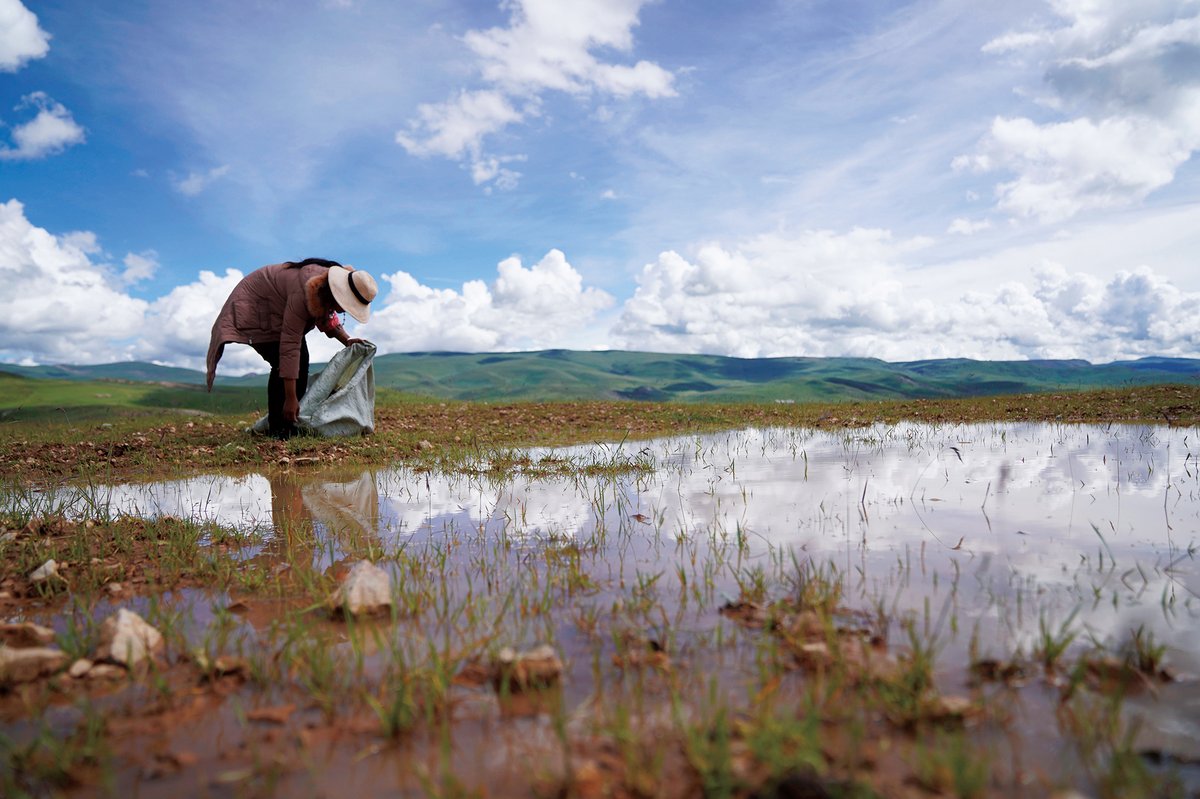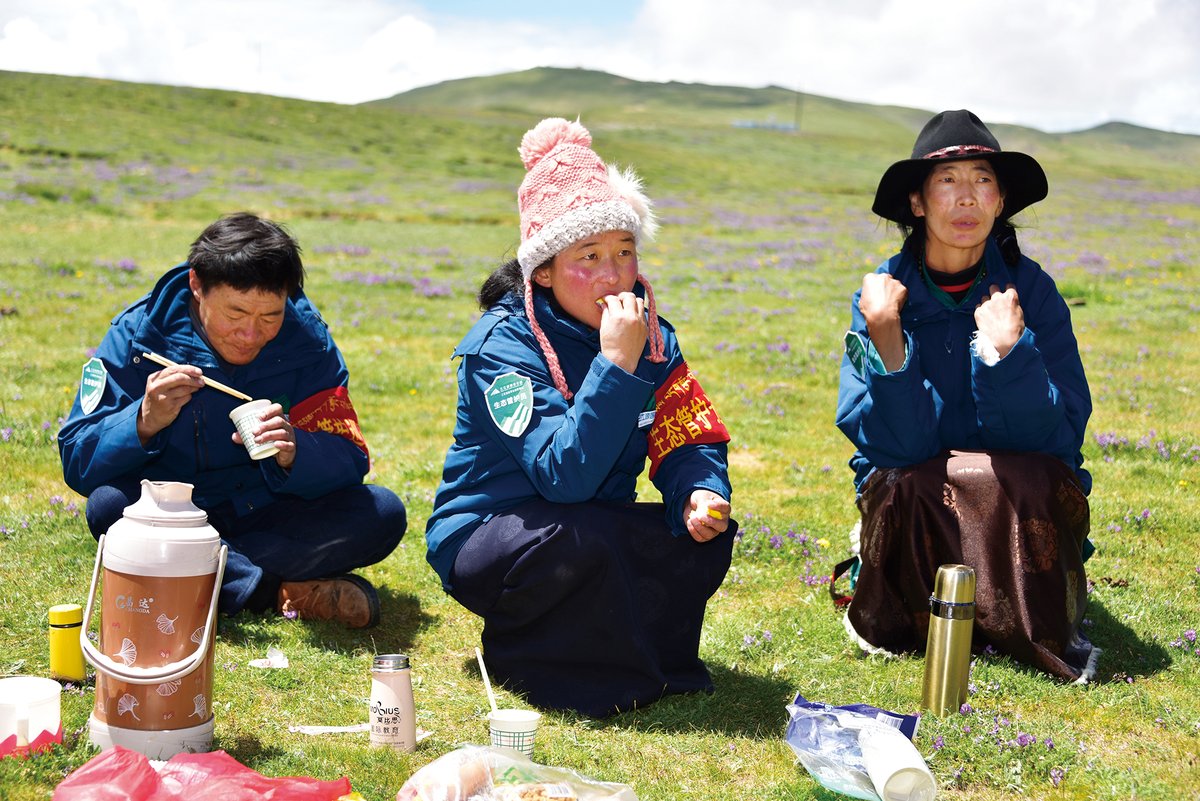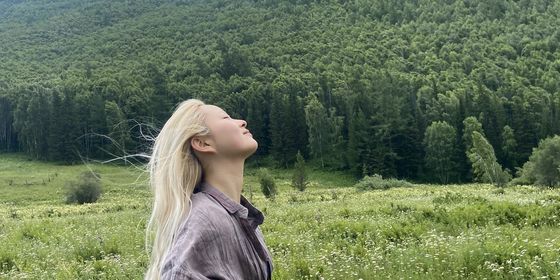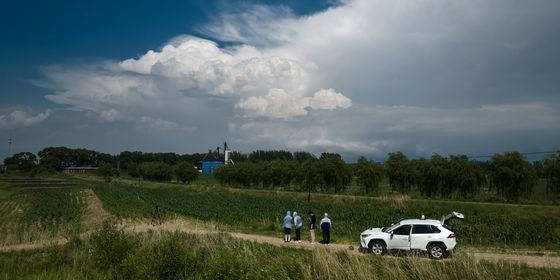As China aims to create 60 national parks by 2035, what will happen to the 12 million human residents inside protected areas?
On the rough cement of a pitch-black village road sometime before midnight, a family hacked at the hind meat from the carcass of a cow.
“It starved to death because there wasn’t enough land to graze,” claimed one man. The family was in a rush to get the cuts to market by morning, as their livelihood largely depended on their cow herd, which grazed illegally within the bounds of Momoge National Nature Reserve, a 1,440-square-kilometer wetland in northeastern Jilin province in which the family lives.
It is estimated that 12 million people live within the borders of China’s sprawling system of over 1,600 nature reserves, where residents and conservationists are set on a collision course.
“Ecological protection and economic development have always been at odds,” sighs Zou Changlin, a park ranger at Momoge. “And we are a classic example of this historical problem.”
The reserve was created in 1981 to protect Siberian cranes, a critically endangered species according to the International Union for the Conservation of Nature, and for which loss of habitat along their migration route is a key threat to survival. As China’s northeast has industrialized over the past century, more and more cranes are squeezed into Momoge’s shallow waters to refuel along their 10,000-kilometer flight.
When Ranger Zou began working in the park in 2003, only around 300 Siberian cranes landed in Momoge each year. Now, a staggering majority of up to 3,200 of the world’s remaining population of 4,000 Siberian cranes land in Momoge each year. “They have nowhere else to go,” says Zou. Yet Momoge’s protection zone also includes 102,000 people who had lived in the area’s 37 villages long before the reserve was built.
Coexistence between humans and nature are a key question facing China’s new system of protected natural areas, as China seeks to create an “ecological civilization,” to quote President Xi Jinping’s guiding philosophy. In the shifting tide of China’s political priorities, environmental targets are coming to the forefront, after decades of promoting rapid economic growth over all else.
China is one of 17 “mega-biodiverse” countries in the world, according to the United Nations Environment Program, hosting 12 percent of plant species and 15 percent of all vertebrates on earth. However, degrading ecosystem health is driving rapid loss of habitat. Since the 1950s, over a half of the country’s coastal wetlands have disappeared to land reclamation; only 5 percent of land cover remains primary forest; more than a quarter of China’s grasslands were lost to farming and mining activities in just a decade, and 90 percent of the country’s remaining grassland is in poor condition.
Last year, the National Development and Reform Commission and Ministry of Natural Resources jointly released ecological targets for natural forests, grasslands, wetlands, coastlines, marine environments, and endangered species, including a goal of creating 60 national parks by 2035.
The central government has been laying the groundwork for national parks for over a decade, approving establishment of a national park management office in 2008, which launched nine pilots in 2015. Two more pilots were added in 2019, and many were declared operational last year. These areas were chosen based on a sweeping national ecosystem mapping project led by Ouyang Zhiyun at the China Academy of Sciences that drew from 100,000 field surveys and 200,000 satellite images to map China’s ecosystems on six indicators.
“I was speaking with some scientists based in the US and elsewhere outside China, and they remarked it’s the kind of ambitious, data-focused project that pretty much only China can pull off,” Rudy D’Alessandro, the US National Parks Services’ international cooperation specialist, said at a public forum at Princeton University’s Woodrow Wilson Center last year.
China’s protected areas are experiencing ongoing reorganization from 13 to just three classifications: national parks, nature reserves, and natural parks. National parks, the crown jewels of China’s protected areas, now have their own dedicated National Park Service. “They are trying to do what America did in 100 years, but in ten years,” Jonathan Jarvis, former director of the US National Parks Service and a consultant to China’s largest national park, Sanjiangyuan, in the northwestern Qinghai province, said in a 2019 conversation with news site Pandaily.
Some have likened Sanjiangyuan to the first national parks in America, with Associated Press calling it “China’s Yellowstone.” However, while there are no people who currently live in Yellowstone, there are 64,000 people who live in Sanjiangyuan, which is roughly the size of Texas.
One of the biggest decisions facing each park is whether to relocate their human populations. Environmental philosopher Fan Yangcheng, associate professor at Beijing Forestry University, writes in a 2021 paper that the US-modeled idea of national parks should be “transplanted into the third world” with caution. She points out that America’s earliest national parks were emptied of people at gunpoint. Yellowstone forcefully relocated the Shoshone, Lakota, Crow, Blackfoot, Flathead, Bannock, and Nez Perce Peoples within its borders. In 1877, a conflict between the park authorities and Shoshone residents killed as many as 300 people.
Fan suggests that Chinese national parks should instead be conceived of as controlled ecosystems where human populations live in symbiosis with nature. Relocations should be conducted on the principles of informed consent, participation, and sufficiency, if at all.
While possible relocations from core conservation zones are written into the government’s 2035 plans as “ecological migration,” and China has its own track record of heavy-handed forced relocations to reach political goals, some administrators have reassured the public that it will not be a strategy taken lightly.
In Momoge, Ranger Zou notes that while relocating humans would be good for conservation, the amount of compensation necessary to make it appealing for residents to willingly move is prohibitive.
In Shandong province on the east coast, where the Changdao Marine Ecological Civilizational Pilot Zone is an official candidate for a marine national park, the average household income from the fishing industry is 400,000 to 500,000 RMB (over five times the national average), making it difficult for the local government to grant potential relocates a similar standard of living.
In 2018, Zhang Shanning, deputy director of the Northeast Tiger and Leopard National Park, told China News that relocations are “only one option, not a preferred option or a necessary one,” and “never one size fits all.” The park has the most residents of any national park, numbering 93,000 people. “Migration will only be considered when people and tigers are incompatible,” said Zhang.
The Hainan Rainforest National Park in China’s southernmost province, created to protect China’s last remaining large swath of ancient tropical rainforest not transformed into monoculture, is home to the island’s endemic Hainan gibbon. Only 30 are estimated to remain. The area is also populated by 30,400 humans, many of whom are ethnic Li people, who have lived on the island for thousands of years.
When Changjiang county party secretary Huang Jincheng received instructions to relocate 3,181 residents living in 13 villages in Wangxia township, he penned an official proposal to the Hainan Provincial People’s Congress to not relocate the residents, stating that “there are many problems in the implementation of ecological migration, such as residents’ attachment to their homeland, the difficulty of land allocation in new areas, lack of income opportunities in new areas, and difficulty of integrating into the new environment.”
The People’s Congress accepted Huang’s proposal, and Wangxia has instead been transformed into a cultural tourism project around Li culture, preserving the villages for folk song and dance performances for tourists. Meanwhile, Huang notes that a policy in which all children are guaranteed free enrollment, food, housing, and medical expenses at the county’s ethnic middle schools is driving natural depopulation of the villages as young people leave for towns and cities.
However, not all counties in Hainan are following Huang’s model. Baisha county relocated 498 people at the beginning of this year, and Wuzhishan city is in discussions with residents to relocate 491 people.
In cases where people are allowed to remain, industry must typically move outside of the park’s bounds. This is no easy feat: In 2016, the Ministry of Environmental Protection (now the Ministry of Ecology and Environment) estimated there were 104 quarries, 318 industrial mines, and 335 energy facilities in China’s nature reserves, in addition to 580 illegal mining operations.
Seventy-seven former forest farms located inside Tiger and Leopard Park are in the process of being merged and transformed into forest management sites. Additionally, residents have been ordered to keep their cattle in pens for much of the year in order to preserve grazing areas for the deer that tigers and leopards feed on, or else face a fine. The cost of buying industrial cattle feed is so high that many are reportedly selling their livestock.
While the protection of core conservation zones is paramount to preserving China’s key ecosystems for future generations, administrators face the challenge of how to reemploy locals. The most obvious options are employing them within the park administration and encouraging job creation through the tourism industry. The growing Chinese middle class and rising interest in nature-based tourism make some experts hopeful tourism can pull local economies forward.
Sanjiangyuan National Park on the Tibetan Plateau protects the source of three of Asia’s largest rivers, the Yangtze River, Yellow River, and Lancang (Mekong) River, which provide water for 900 million people downstream. Its “One Family, One Ranger” program has created 17,000 patrolling jobs, one to each family, paying about 2,000 RMB per month. However, the salary for rangers is still only a fraction of average household incomes, which still rely more on yak grazing and harvesting caterpillar fungus.
Sanjiangyuan is home to Valley of the Cats, the first franchise within a Chinese national park, where domestic and international tourists are taken on safaris to spot snow leopards. Managed by locals under the guidance of the Chinese NGO Shanshui Conservation Center, 100 percent of the proceeds for transportation and homestays go to the local community.
British conservationist Terry Townshend, who helped develop the community tourism project, wrote on his online blog in 2019 that among the early visitors were Scottish couple Graeme and Moira Wallace, who flew 10,000 kilometers to spend their 40th wedding anniversary there, and were elated to encounter a snow leopard 160 meters from their vehicle. However, Townshend concluded that the “standard of accommodation, food, and toilets mean that this type of tourism is only for the adventurous traveler.”
At the same time, the entrance fee and costs of visiting a park are prohibitive for average Chinese people. “If most people can’t afford to visit national parks, the parks will lose their educational and recreational meaning,” wrote a team of researchers led by Linghong Kong of Global Environment Institute in a 2018 paper. They cited Potatso National Park, whose admission fee of 258 RMB was equal to roughly 1 percent of the national median after-tax annual income of 27,540 RMB in 2020 (this proportion to income would be equal to 350 USD in the US).
The Changbaishan Nature Reserve of southeastern Jilin employs 1,000 locals as rangers, shuttle drivers, and staff—many of them are former forest farm employees, now charged with protecting the forests, albeit on precarious contract pay.
Nearby, snowy slopes have become home to China’s premier ski resorts, leading the 60,000 locals of the town of Erdao Baihe to open hotels, restaurants, and convenience stores, also finding employment in a bottling plant for the reserve’s spring water. Wang Shaoxian, director of the reserve’s Academy of Sciences, expects the site will soon make it onto the expanding roster of national parks. “If we become a national park, our territory will expand. Protection comes first, tourism and economic activities come second, though both must go hand in hand,” he noted.
Among Wang’s long-term hopes is for the Siberian tiger to return to Changbai Mountain, where they haven’t been spotted since 1976—an ambitious goal, as a mating female requires 500 square kilometers to roam.
Early one summer morning, after weathering hours of bumpy detours due to impromptu road closures, TWOC arrived at the gate to Momoge National Nature Reserve to find the entrance ticket booth empty.
Park employees, found in a back office, stated glibly that the electronic gate was broken. Inside the gate, TWOC was greeted by cages with 30 red-crested cranes, said to be injured, shifting idly in captivity. The lights to the museum introducing the reserve’s biodiversity were off. Needless to say, the reserve was devoid of visitors.
Not all parks and reserves have been so successful at boosting the local economy. In protected areas without ecological industries like Changbaishan, or highly organized local initiatives supported by NGOs like Sanjiangyuan—those who live inside these areas are often left worse off. In remote areas, there is little tourist infrastructure to support the supposed wave of ecotourism that is meant to buoy local communities.
In a 2018 study of 1,510 households in six giant panda nature reserves in the impoverished Qinling Mountains of Shaanxi province, researchers discovered that nature reserves reduced incomes as cropland was converted to conservation sites, and income inequality inside the parks increased as some households with more resources took on tourism-related work as guides, drivers, and souvenir-sellers.
In Potatso National Park in Yunnan province, established in 2008, the park took a more proactive approach, signing a five-year, 500 million RMB contract with locals, who were compensated according to their distance from the park. However, when it came time to renew the contract, community residents demanded a higher sum. “The park had no choice but to agree,” wrote Kong. “It is easy to cultivate people’s dependence.”
In contrast, Momoge has hired only 30 locals, with Ranger Zou noting that for 2,000 RMB per month, young people are either not willing to work or else want to leave quickly. “Locals would see the importance of conservation if their livelihoods were related to it, instead of in conflict with it,” he says.
Buy-in from local communities is vital to conservation work—it’s win-win, or lose-lose. In Momoge, locals openly flout all kinds of reserve rules, from anti-grazing to waste disposal. Rangers have enacted public education programs in local villages, but it has not stopped trash piles from forming in the grassland. A nearby resident recalled with a chuckle that some years ago, he drove into the reserve and picked the endangered cranes up by their necks to pose for photos for fun.
In many nature reserves across China, often in poor and remote counties, ecological education and management have not yet created incentives for locals to care about conservation—or simply, locals face few alternative livelihoods. Livestock are not allowed to graze within the Momoge reserve boundaries, but authorities are aware of these transgressions, and simply urge locals to “graze less, or not in the main areas, especially during bird migration season.”
However, China’s first batch of pilots show that responsive governance and local participation in the planning and implementation of park policy contribute to environmentally and economically thriving protected areas, and will be necessary to get a truly “ecological civilization” off the ground.
Or else, there is a steep price to pay—for China’s threatened biodiversity, as well as some of its most vulnerable communities. Ranger Zou shrugs, empathizing with local residents’ lack of viable alternatives to setting their cowherds to graze: “Are you going to have the people who live here starve to death?”
The Myth of the Chinese Wilderness is a story from our issue, “Call of the Wild.” To read the entire issue, become a subscriber and receive the full magazine.
















